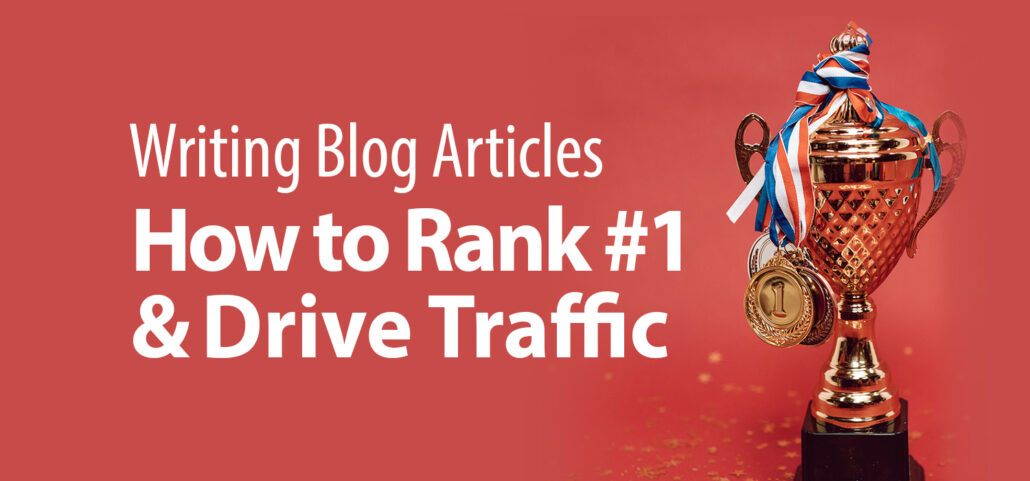
There are quite a few ways to go about writing a blog. From listicles to industry news, typically one of the key objectives is to publish articles that engage your reader, leaving a positive impression of the authoring brand as they part ways from the content.
While promoting our posts via social media and email campaigns are great ways to get initial visibility, an article ranking well in the SERPs is the best way to attain sustainable traffic for the long term. Accomplishing this, however, is not the easiest of tasks.
Developing blog content that hits search intent and impresses the algorithms
Search query to search query, Google’s modern algorithm does its best to provide its users with the highest relevance and value. Therefore, to maximize potential for exposure, we need to ensure our articles are developed properly to fall in these categories of contention. We attempt to do this by striving to be better than the tens of thousands of competitors producing similar article concepts.
It’s important to mention that not every article needs to be Google-fearing. Some articles can simply be for a social or email audience where you do not have to consider depth of coverage to outflank the #1 ranking competitor or where keyword targeting isn’t the least bit important. However, in the case you are genuinely setting out to drive traffic on an organic level, there are quite a few things to be aware of to increase each article’s success rate in the SERPs.
What needs to be distinguished early on in the topic development process?
- Does my topic have search volume and long-lasting shelf life?
- Is the topic relevant and an extension of the ‘service’ keyword we’re looking to support?
- Will research beyond the basics be required to showcase authority and expertise for my topic?
- Who are my competitors and what does my article need to consist of to compete for #1?
- Do I have a firm understanding of search intent for the core queries my article will rank for?
- How long should my article be to contend for the top spot?
- Is my article answering a single query or a broader query that will require elaborate inner topics to ‘answer’?
- Does my topic have potential to deliver more than just top of funnel traffic?
Below I have broken up this write-up into two parts.‘The Initial Research’ which essentially lays out how to target organic topics with confidence and ‘Writing the Article’ which provides a framework for building out an article primed to appease Google.
The Initial Research
While research is a common part of the content creation process, it’s easy to miss some important SEO elements that will stifle your chances of publishing a ‘hit’ article from the very start. Many content developers make the mistake of thinking it’s enough to simply target a few relevant keywords with search volume, hash out 500 words, add some links and call it a day.
At the risk of being too blunt, that’s ‘dime a dozen’ content. That’s how the majority of agencies and in-house communication specialists are doing it. We need to be better. We need our content to present our brands as the authority – and outputting articles that look no different than their competitors is not going to achieve that.
It all starts with research. Research that identifies and maps out all that is required for a piece to have the highest odds of seeing success in the search engines.
Identify the Service Keyword/Page You Ultimately Want to ‘Feed’
Aside from the positives of creating brand awareness, articles are a great way to impress Google’s algorithm. It’s another opportunity to invite Google to grow in familiarity and trust with our website. These opportunities amplify when they deem an article as top rank material. Meaning, when an article ranks one of our articles #1 for a set of keywords, Google will hold internal and external links referenced in the body in higher esteem.
That said, it’s important that each planned article needs to reference at minimum a single relevant service page as a key benefactor of any ‘SEO juice’ passed. ie: If my campaign is focused on growing search visibility for ‘plumbing repair’, I’m developing relevant topics to support and link to it within context. If my articles fare well, naturally we can expect our referenced service page to see the positive effects.
Identify Topical Keywords You Want to Target
When brainstorming topics, there are four things to consider before you should justify and commit to your selection.
Your topic aims to showcase industry expertise
If we want to emit expertise on a particular service, we need to select worthwhile topics and provide proper coverage. From ‘what is’ to ‘how to’ queries, all relevant content that provides value to the seeking audience will not only paint a brand in a positive light, it grants web authority. While this may not necessarily generate a great percentage of direct tangible leads, it surely has some powerful indirect benefits.
- Opportunities to pass more internal ‘link flow’ (especially to appropriate service pages)
- Opportunities to attain backlinks and brand mentions
- Increased brand awareness
- Increased crawling opportunities and trust building with Google
Your topic has search interest
One of the greatest tragedies of writing an article is when you spend hours on it only for it to go perpetually unseen. While there are usually a few reasons for this mishap to have occurred, one of the top reasons is there was no search interest for the topic to begin with.
Want to ensure your article does not meet its end in a future audit (with a head shake from a judgemental SEO)? Here are a few ways to confirm:
- Check that your topic’s set of core keywords has relatively good search volume.*A
- Check that your topic has high potential to rank meaningfully for other relevant supportive keywords (usually targeted in inner topics of your article).*A
- Check that the top ranking article has a solid keyword profile with search volume.*B
- Check Google trends to identify the seasons, peaks and valleys of the topic at hand. *C
*A tool such as SEMrush or ahrefs should help you confirm these points.
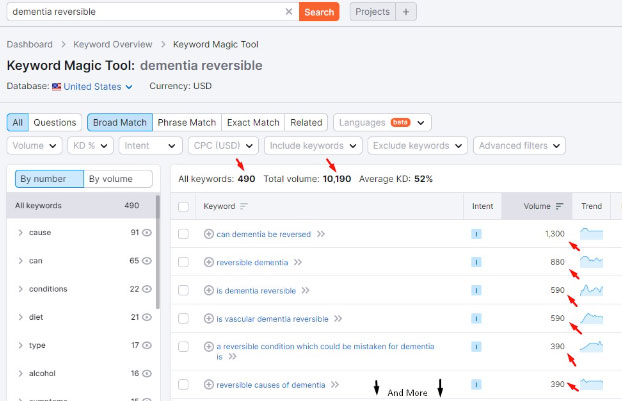
Access these insights: Log into SEMrush > Select Keyword Magic tool in left nav > Enter keyword in field + click search

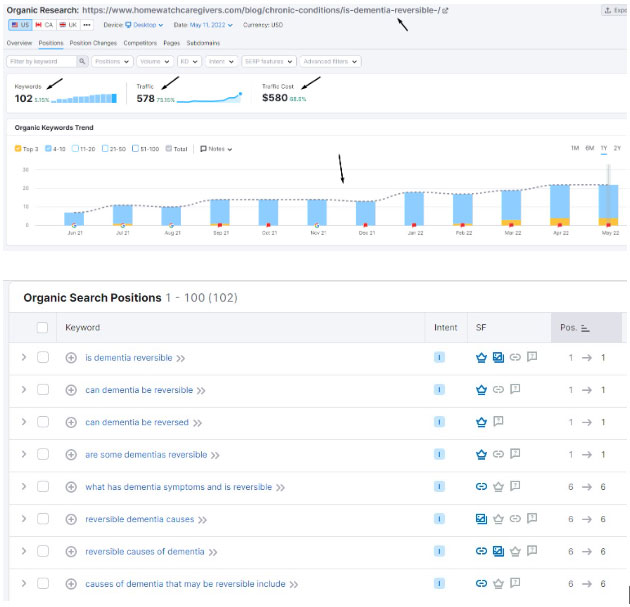
Access these insights: Log into SEMrush > Select Organic Research in left nav > Enter full URL of article + click search
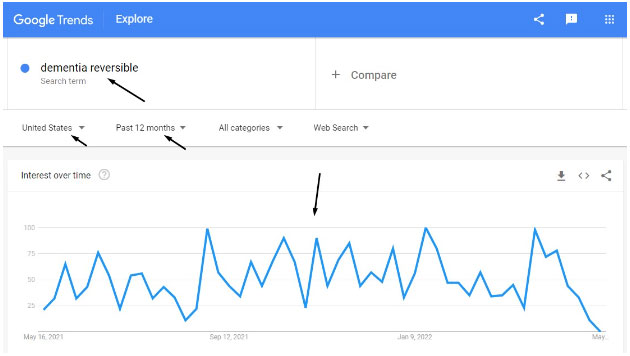
Access these insights: Go to Google Trends > Enter search term + click search icon
You know who your competition is for your topic
Like a boxing challenger looking to take out the reigning champion, we need to know what we are up against. The idea is the top 3 articles for our core query are who we need to have our sights on, as they’re the ones eating up the bulk of the click-thru. With that said, to know our competition, it’s helpful to know the following:
- Who does this article belong to (a competing brand, publisher, etc.)?
- How much domain authority do they have?
- How aged is their article?
- Which top 10 keywords is their article ranking for?
- What kind of traffic is it estimated they are pulling in?
- What kind of inner topics are they covering?
- What kind of supportive visuals or media did they incorporate?
- How comprehensive is their article and how many words are included?
- Which other articles are they internally linking to?
- Which other articles are linking back to their article?
- What external resources is their article linking to?
- Which keywords are they ranking 11-20 for?
- What are missed opportunities we can capitalize on to provide the reader more value?
When we know the answers to these questions, we have a better understanding of what will be required to not only replicate our competition’s success, but outflank them too.
You understand the search intent for your topic
Knowing search intent is vital when committing to a topic, so you can be confident your article will fall in line with what Google is likely to favor for a particular query.
Important things to acknowledge in understanding search intent come from researching the SERPs for the keyword you are targeting. Notate the following:
- What type of pages are ranking?
- Which websites (organic competitors) are ranking?
- What is the make-up of the immediate SERP layout?
- Paid ads
- Pure results
- Featured Snippet
- Local Map Pack
- Knowledge graph
- People Also Ask
- What’s being covered on the ranking pages?
It just helps to understand the moving parts associated with a keyword.
Also, for a more elaborate explanation on this subject, Moz has a great guide dedicated to understanding the different types of search intent. I highly recommend giving it a read, but to give you a quick breakdown, the different types of search intent include:
- Informational – Users are seeking information or an answer to a query. Think ‘how to’ guides, ‘what is’ articles, etc.
- Commercial Investigation – Users are a step beyond the informational stage, taking their research to the step of comparison. Think ‘best xyz service’, ‘brand xyz reviews’, etc.
- Transactional – Users are ready to make a purchase. Think ‘buy brand abc product xyz’.
- Navigational – Users are looking to navigate to a specific website. Think ‘contact brand xyz’, ‘brand xyz blog’, etc.
In the end, the last thing you want to do is develop an article intended for a particular keyword, but have it end up in no man’s land due to missing the mark of what a search is after. Maximize your article’s opportunity to rank by providing the most value for intent in question!
Standard Query Articles VS Authoritative Articles
Standard Query Articles
These types of articles seek to answer a single, straight-foward query and can typically range from 500 to 2,000 words. Some examples include:
- Listicles
- ie: X Things Not to Pour Down Your Drain
- Checklist articles
- ie: Shower Cleaning Checklist
- ‘Best’ Articles:
- ie: Top 5 Drain Cleaners for Unclogging Your Drain
- ‘How To’ simple query articles
- ie: How to Unclog Your Drain
- Single query articles
- ie: Can Coke Unclog a Drain?
- ie: Why is My Drain Always Getting Clogged?
- ie: What is the Cheapest and Most Effective Drain Cleaner?
Authoritative Articles
Authoritative articles seek to answer a broader topic in an in depth fashion (and can be perfect for referencing and linking out to more focused standard query articles). It will depend on the topic, but authoritative articles can range from 1,000 to over 5,000 words. Some examples include:
- Guides:
- ie: The Ultimate Plumbing Guide for Homeowners
- ‘How To’ complex query articles
- ie: How to Become a Professional Plumber
- ‘Everything’ articles
- ie: Everything You Need to Know About Plumbing When Building a House
Regardless of article type, what matters most when developing traffic-driven informational content is that your topic has search interest and your content hits the right angle from a search intent perspective, all while providing the most value amongst the competition. Do this and you’ll increase your article’s chance to succeed in the SERPs as well as your overall ‘hit rate’ as a blog writer.
Read this article: What is Authoritative Content?
Writing the Article
Now that we’ve covered the research aspect of article development required to improve our chances of hitting a homerun in the search results, it’s time to execute. Here we’ll dive into best practices for writing articles with topical SEO and optimization in mind.
A Great Title Goes a Long Way
We need our audience to make the decision to view our article in the first place, so it’s important our titles capture their attention enough to induce a click.
A great title will:
- Include the problem and/or solution
- Include the core keyword
- Evoke emotion
- Afford a promise of value
- Align with the contents of the article
Tip: Keep your titles under 60 characters to avoid truncation.
Read this article: Types of Blog Post Types That Get Clicked: A Beginner’s Guide
Meta Description:
Here’s where you can really drive a click. A meta description needs to succinctly expand on what the reader can expect of the article that awaits them. Be sure to include a relevant call to action at the end.
Tip: Keep your meta descriptions under 160 characters to avoid truncation.
Keep Your Competing Article/s Close By
It’s time to reference the insights taken from your competing article analysis during the research process.Ultimately, it’s your objective to decipher their content ingredients and figure out why Google has awarded them top search placement. Reverse engineer and build it back better giving Google a reason to consider your article over your competitors.
Incorporate Framework of Article Topics
As a copywriter, you’re likely no stranger to building out a content framework for a piece you’re putting together. There are some things to be mindful of from an SEO perspective.
Topical headings are a VERY powerful way to inform Google of what your article is about. And when Google knows what your page is about (and the content backs it up with value), you have an amplified chance of seeing it reflect well in the rankings. Other reasons to include headings:
Readers enjoy articles that are easier to digest
When readers love an article, they’re more likely to take a positive action whether it be signing up for a mailing list, further navigating your website, sharing it on their social media or referencing it on their own site with a backlink! A positive non-action might simply include increased brand awareness and trust, which is also great!
Abundance of opportunities to include relevant keywords
Headings are where your keywords and variation of keywords can display within the context of the article.
Worry less about stuffing in keywords
Headings allow you to write to the topic, which promotes natural keyword inclusion and decreases the need for any shallow form of keyword stuffing.
Utilize Proper Semantic Topics and HTML Headings
Also on this subject, it’s extremely important to cover topics in semantic form, especially for (but not limited to) more in-depth, authority articles. Example:
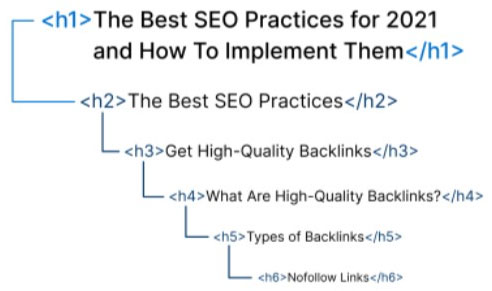
When you structure an article this way, each topic feeds into the parent topic it lives under, ultimately sending an immense amount of ‘weight’ to the main heading (see <h1>). This is how you showcase expertise in a way that resonates with Google and the reader.
While there is no rule of thumb for how many headings per article, use your research, competitor insights and best judgment to determine what will grant you the reigning authority on the topic at hand. Don’t sleep on this practice!
Tip: It’s not uncommon to see bullet points used when a heading will (from an SEO standpoint) serve the page better. Try to save bullet points for short-hand or single word instances of copy.
Use Natural Language and Avoid Blatant Keyword Stuffing
Expanded on what was touched on above, it’s important to reiterate avoidance of forcing in keywords on a general level. Copywriters are not to be a slave to keyword stuffing, but rather, free to use natural language throughout the article. That is what Google and readers like afterall!
This is where having a healthy outline of semantic topics to cover will better help you build out your article with ease.
Keyword Stuffing Example:
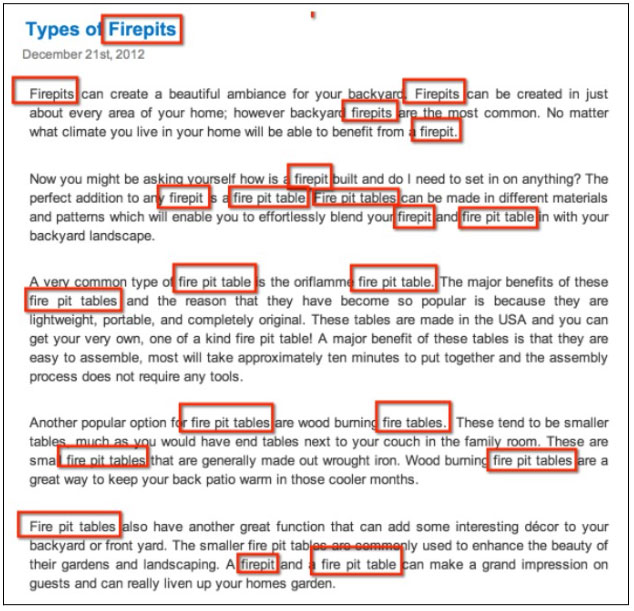
Better Internal/External Linking and Use of Contextual Links
A basic improvement you can bring to your content is increased intentional linking practices. Links with poor standalone context such as ‘click here’ or a one to two word anchor text leave much to be desired from an on-page optimization and user experience perspective.
Contextual links are relevant to a talking point in the article, with seamlessly descriptive anchor text within a sentence. These links have strong context behind them, leading the reader to feel confident in what to expect on the other side of a click.

Tip #1: When writing a piece, do find natural opportunities to reference previous or upcoming applicable articles with a contextual link. It’s details like these that can separate the good articles from the great.
Tip #2: Avoid links in the introductory paragraph unless it’s absolutely necessary for enhancing the reader’s experience for the article at hand (ie: referencing a previous article in the series).
Closing
In closing, should these techniques be incorporated into your blog content research and development process, you can be confident you’re increasing each published work’s ceiling for success in the search engines! Your hit rate will only climb!
Eric Santana
Eric Santana has been an SEO professional for 9 years, with 15 years in digital as a whole. His passion is helping local practices and small businesses achieve organic success without having to go through traditionally overpriced marketing agencies only to achieve mediocre results. Eric is also a husband, father of 3 boys and enjoys all things sports.